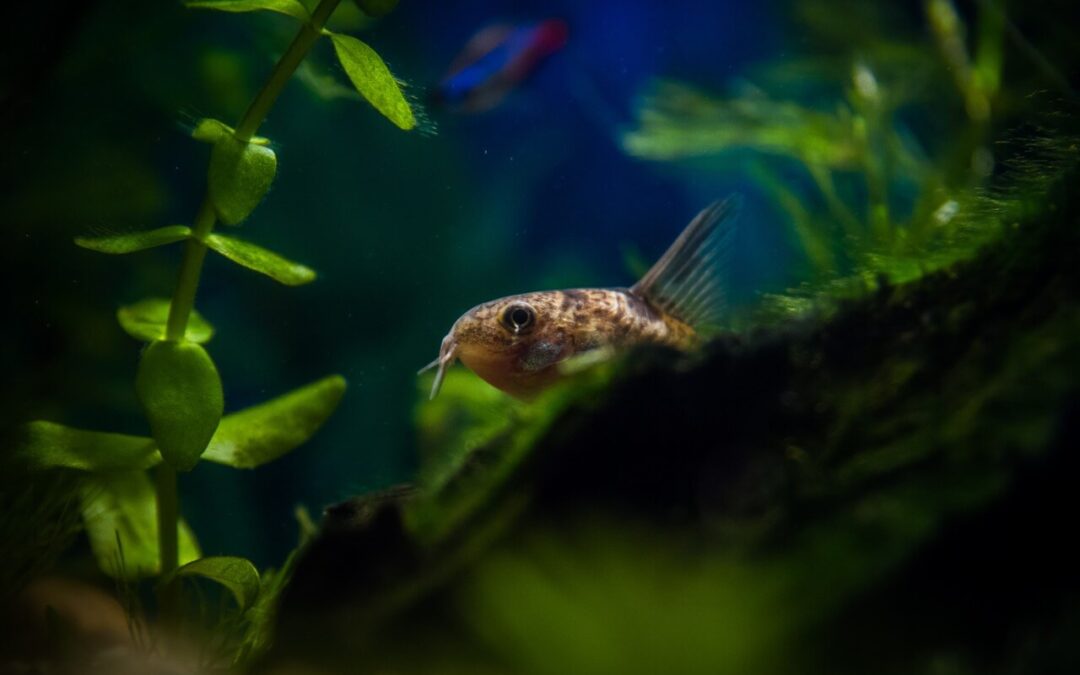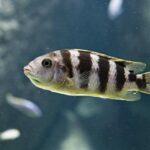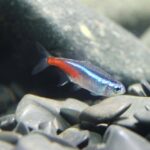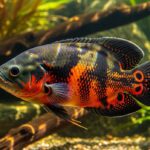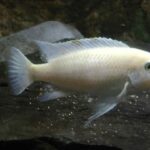Corydoras catfish — affectionately known as “corys” — are among the most popular freshwater fish for home aquariums. Their cute whiskered faces, peaceful personalities, and bottom-cleaning habits make them a favorite among both beginner and seasoned aquarists. But one of the most common questions people ask before bringing them home is: How big do Corydoras get?
The short answer is that most Corydoras grow between 1 and 4 inches (2.5 to 10 cm) in length. However, the exact size depends on the species, gender, and environment. Some stay tiny, like the pygmy cory that barely reaches an inch, while others—like the bronze cory—can reach up to 3 or even 4 inches.
Let’s explore the different sizes of popular Corydoras species, what affects their growth, and how to help your corys reach their full potential size.
Average Corydoras Size by Species
There are over 170 recognized species of Corydoras catfish, each with its own unique look, pattern, and size. While they all share the same general body shape and behavior, the size range can vary quite a bit between species.
Here’s a breakdown of some of the most common Corydoras you’ll find in home aquariums and their typical sizes:
| Common Name | Scientific Name | Adult Size | Ideal Tank Size | Average Lifespan | Special Traits |
| Pygmy Cory | Corydoras pygmaeus | < 1 inch (2.5 cm) | 10 gallons | 3–4 years | Tiny and perfect for nano tanks; very active schooling fish. |
| Salt and Pepper Cory | Corydoras habrosus | 1 – 1.5 inches (2.5–3.8 cm) | 10 gallons | 4–5 years | Peaceful and hardy; often confused with pygmies. |
| Panda Cory | Corydoras panda | 2 inches (5 cm) | 15 gallons | 5–6 years | Adorable black patches around eyes like a panda. |
| Peppered Cory | Corydoras paleatus | 2 – 2.5 inches (5–6.5 cm) | 20 gallons | 5–8 years | Hardy species with a speckled gray pattern. |
| Albino Cory | Corydoras aeneus (albino variant) | 2.5 – 2.75 inches (6–7 cm) | 20 gallons | 5–8 years | Albino form of the Bronze Cory; pinkish-white body and red eyes. |
| Bronze Cory | Corydoras aeneus | 3 – 4 inches (7.5–10 cm) | 25 gallons | 5–8 years | Larger species; metallic bronze coloration. |
| Sterbai Cory | Corydoras sterbai | 2.5 – 3 inches (6–7.5 cm) | 20 gallons | 6–8 years | Known for white dots on dark bodies; thrives in warmer water. |
| Julii Cory | Corydoras julii | 2 – 2.5 inches (5–6.5 cm) | 20 gallons | 5–7 years | Beautiful spotted pattern; often confused with Leopard Cory. |
| Skunk Cory | Corydoras arcuatus | 2.5 inches (6 cm) | 20 gallons | 5–7 years | Distinct black stripe from head to tail; slightly shy. |
| Emerald Cory (Brochis splendens) | Brochis splendens (closely related) | Up to 4 inches (10 cm) | 30 gallons | 8–10 years | One of the largest; shimmering green coloration. |
As you can see, most species stay under 3 inches, which makes them ideal for small to medium aquariums. Only a few reach the 4-inch mark — and even then, that’s usually the upper limit for the largest types.
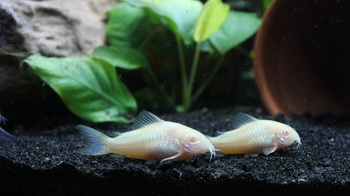
Factors That Affect Corydoras Size
While genetics play a major role in determining how big a Corydoras will get, several other factors can influence their growth rate and final size.
1. Species Genetics
Each Corydoras species has a natural size range that can’t be exceeded even under perfect conditions. For instance, a pygmy cory will never grow as large as a bronze cory simply because of genetic differences.
2. Gender Differences
In many species, female Corydoras tend to be slightly larger and rounder than males, especially when mature. This helps them carry eggs more efficiently during breeding. Males, meanwhile, often have slimmer, more streamlined bodies.
3. Tank Size and Space
Corydoras may be small, but they still appreciate room to swim and explore. A cramped tank can stunt growth and stress the fish.
- For small species like pygmy corys, a 10-gallon tank may suffice.
- For larger types such as bronze or sterbai corys, aim for 20 gallons or more.
Giving them space encourages natural activity, healthier behavior, and optimal growth.
4. Diet and Nutrition
A well-balanced diet is key to helping your corys reach their maximum size. These bottom-dwellers are omnivores, feeding on sinking pellets, algae wafers, bloodworms, and small crustaceans.
Feed them a variety of foods such as:
- High-quality sinking pellets or wafers
- Frozen or live foods (bloodworms, brine shrimp, daphnia)
- Blanched vegetables (zucchini, peas)
A nutritious diet not only helps with growth but also enhances their colors and overall vitality.
5. Water Quality and Environment
Corydoras thrive in clean, well-oxygenated water. Poor conditions can slow their growth and even shorten their lifespan.
Keep these parameters in check:
- Temperature: 72–78°F (22–26°C)
- pH:0–7.5
- Ammonia/Nitrite: 0 ppm
Regular water changes (25–30% weekly) and a good filter help keep their habitat stable and healthy.
6. Social Behavior and Stress
Corydoras are schooling fish, meaning they feel safest and happiest in groups. Keeping at least 6 of the same species encourages natural behavior, reduces stress, and supports healthy growth. Stress from isolation or aggressive tankmates can slow down their development.
Growth Timeline: From Juvenile to Adult
Corydoras grow relatively quickly under good care. Here’s what their growth stages typically look like:
- Weeks 1–4: Hatchlings measure around 0.1 inch and grow steadily as they feed on microfoods or infusoria.
- 1–3 months: They reach about 0.5–1 inch, depending on the species.
- 3–6 months: Most corys are juveniles by this stage and show visible coloration.
- 6–12 months: They reach adult size, usually between 1–3 inches. Larger species might take a few extra months to fully mature.
With proper feeding and water care, most Corydoras will reach their adult size within the first year.
Best Tank Setup for Healthy Growth
To ensure your Corydoras grow well and stay active, it helps to mimic their natural habitat — the slow-moving streams and rivers of South America.
Here’s how to set up an ideal environment:
- Substrate: Use smooth sand or fine gravel to protect their sensitive barbels (whiskers).
- Plants: Add live plants like Java fern, Amazon sword, and Anubias for cover and oxygen.
- Hiding Spots: Include driftwood, caves, and rocks to create cozy resting areas.
- Lighting: Moderate lighting works best — not too bright.
- Filtration: Use a gentle filter to maintain water quality without strong currents.
A peaceful community tank with similar-sized, non-aggressive fish is ideal. Tankmates like tetras, rasboras, and guppies make great companions.
Fun and Interesting Facts About Corydoras Size
- Tiny but Mighty: Despite their small size, Corydoras are incredibly hardy and can live up to 5 years or more with proper care.
- Built for Teamwork: In the wild, they form shoals of hundreds of individuals! This social lifestyle helps them feel secure and reduces stress.
- Armor-Plated: Their name “Corydoras” comes from Greek — kory (helmet) and doras (skin) — referring to their bony plates that act as armor.
- Breathing Trick: Corydoras can gulp air from the surface and absorb oxygen through their intestines — a clever adaptation for low-oxygen environments.
- Growth Spurts: Younger Corydoras grow rapidly in their first few months, especially when kept in warm, clean water with plenty of food.
How to Tell if Your Corydoras Are Growing Properly
You can tell your Corydoras are on track if they show:
- A round, well-fed belly (without bloating)
- Active foraging behavior along the substrate
- Bright, clear eyes and smooth barbels
- Consistent color and no clamped fins
If your corys appear thin, inactive, or pale, it could be a sign of poor diet or water conditions. Regular monitoring and small adjustments can quickly get them back to health.
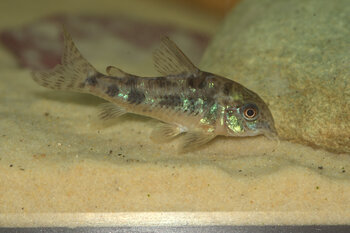
FAQs About Corydoras Size
1. What is the largest Corydoras species?
The Bronze Cory (Corydoras aeneus) is among the largest, reaching up to 4 inches in length. However, most species rarely exceed 3 inches.
2. What is the smallest Corydoras species?
The Pygmy Cory (Corydoras pygmaeus) is the tiniest, growing to less than 1 inch — perfect for nano or desktop aquariums.
3. How fast do Corydoras grow?
Under good care, they reach most of their adult size within 6 to 12 months. Growth may slow afterward as they mature.
4. Can Corydoras outgrow their tank?
Not usually. Corydoras stay relatively small, but keeping them in too small a tank can stunt their growth and cause stress.
5. Do female Corydoras grow larger than males?
Yes, in most species, females are slightly bigger and rounder, especially when ready to spawn.
6. Can Corydoras size indicate their age?
Roughly, yes. Younger corys are smaller and slimmer, while older ones have fuller bodies. However, growth rate depends heavily on environment and diet.
7. What’s the ideal tank size for a group of Corydoras?
For small species like pygmies, a 10-gallon tank can work for a small group. For larger species, start with 20 gallons or more to give them space to thrive.
Final Thoughts
Corydoras catfish may be small, but they have big personalities and play an important role in maintaining a clean, balanced aquarium. Most species grow between 1 to 4 inches, with the majority staying under 3 inches — making them perfect for community tanks.
Their size depends largely on the species, diet, and care they receive. With clean water, good food, and plenty of friends to swim with, your corys will reach their healthy adult size and reward you with years of charming bottom-dwelling activity.

